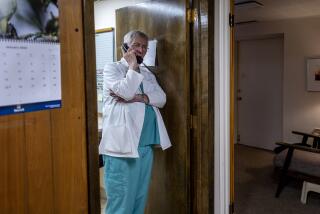When ‘natural’ seems too risky
- Share via
THROUGHOUT her pregnancy, Susana Hellmuth, 35, felt as if she were walking on eggshells. The Culver City woman had had two previous miscarriages, one heartbreakingly late, just as she entered her third trimester. This time, as a precaution, she spent the final six months in bed. Finally, a few weeks before her due date, she asked her doctor to schedule a cesarean section.
“After six months of not doing anything, the last thing I wanted was complications at birth,” she says.
Dr. Chalil Tabsh, her physician and the medical director of the perinatal center at Santa Monica-UCLA Medical Center, said Hellmuth probably would have had a successful vaginal delivery. But he adds: “I think if somebody can decide to step into a plastic surgeon’s office and have her breasts enhanced -- unindicated surgery -- she can have an elective C-section.”
Surgical childbirth -- in existence since ancient times and made increasingly safe after the advent of anesthesia and antibiotics -- has saved the lives of untold millions of women and their newborns. But more women than ever are now making it a personal choice, opting to never feel a labor pain, never practice Lamaze breathing, never be coached to push.
The trend has been fueled by evolving medical opinions and new research.
In 2003, the American College of Obstetrics and Gynecology said that physicians are ethically justified in acquiescing to a woman’s request for the surgery, provided the patient understands all the risks. That stance opened the door to making elective surgery a legitimate alternative for healthy pregnant women to discuss with their doctors. Meanwhile, some research has suggested that vaginal delivery creates its own risks and that C-sections help women avoid incontinence and other health problems down the road.
Even newer studies are beginning to compare the risks of vaginal delivery not with emergency C-sections, as most previous research has done, but with planned surgical deliveries. C-sections are safer, some researchers are finding, without the last-minute rush to surgery after an exhausting trial of labor. But critics of elective C-sections see a downside. Such research is early and conflicting, they say, and science doesn’t yet understand the time-honored trip down the birth canal. Babies delivered by cesarean section have more respiratory infections later in life, and may have more gastrointestinal tract problems as well. And errors in predicting the due date could result in a baby born earlier than the full-term range of 38 to 41 weeks.
Still, elective cesarean is beginning to have a small but noticeable effect on the growing number of C-sections overall. In one study, conducted from 2001 through 2003, the last year for which statistics are available, 127,762 American women in 17 states chose the knife over waiting for the first pains of labor -- 25,140 of them in California.
The numbers, issued in a September 2005 report by Health Grades Inc., a healthcare ratings service, represent 2.55% of births in the U.S., up from 1.87% in 2001. Dr. Samantha Collier, vice president of medical affairs for the service, has reported on elective cesareans for three years. “The first two research findings were not a fluke,” she said. “We’re seeing significant growth rates year after year.”
The increase in elective C-sections comes amid a rise in C-sections overall. In 2004, close to 30% of all births were cesarean, up from about 20% in 1996.
Often, women needing C-sections are wheeled into a surgical suite after labor has begun, because the baby is too big, too small or not getting enough oxygen or the mother is bleeding heavily. The most prevalent reason women have C-sections is because they’ve already had one. Vaginal birth after a previous cesarean, termed VBAC, is medically possible, but the number of such procedures is falling. Those women have increased risks, including hemorrhaging from the previous incision, and physicians and hospitals have grown wary of lawsuits.
Some 80% of obstetrical lawsuits claim that an indicated cesarean was not done or was done too late, says Dr. Jeffrey Phelan, a Pasadena obstetrician who is also an attorney.
Today, nearly 90% of women who have had a C-section deliver their next babies surgically, up from a low of 72% in 1996.
Amid this growing overall trend, the number of elective C-sections is only likely to increase.
Hellmuth, for one, is a firm believer in surgical intervention.
On Dec. 18, in a surgical suite at the medical center, her son Nicholas arrived through an abdominal incision, full term, normal and healthy.
“It’s certainly easy on the mom,” Hellmuth says. “I didn’t have to do anything except lie there.”
Avoiding future damage
For the cesarean to be considered elective, the woman decides on surgery well before her water breaks. Labor has not begun at the time of the scheduled surgery, and there is no precipitating medical problem.
Whether out of a fear of pain, fear of damage to their own internal organs from vaginal delivery, fear for the baby’s safety or a need for control, women who have an elective C-section do not go through the time-tested ordeal of labor and delivery.
For Karen Tse-Chang, 37, the choice was based on flashbacks to hemorrhoids after the 2001 vaginal birth of her first child. Her pregnancy had gone smoothly. Labor was short, delivery uncomplicated. No surprises -- until she tried to sit. “I got home. I couldn’t sit. I couldn’t lie down. I could barely move. It was agony,” she says. Never again, she thought.
So when she got pregnant with her son two years later, she asked well in advance to have a cesarean section, even though hemorrhoids don’t rise to the level of a medical complication requiring a C-section. “It was well planned. I looked at the calendar and said, OK, this is a good day,” she says, picking 10 days before she was due. “I knew I was trading one pain for another. But at least with surgical pain, I could take pain medicine,” she says.
For her, recovery from the incision was more painful than she expected -- but no worse than her experience with hemorrhoids. “I don’t see any difference, natural or C-section, as long as you know what you’re getting into.”
Cesarean and vaginal births each have advantages and drawbacks for the woman, for the baby and for future pregnancies.
In the United States, the overall infant mortality rate is 6.9 per 1,000 babies; the maternal mortality rate is 11.8 per 100,000 live births, and estimates are that a C-section more than doubles the mother’s risk of death. When an infant dies in childbirth, it can take a court of law to figure out if a different birth process would have made a difference.
But in the overwhelming majority of childbirths in the U.S., mother and baby do just fine, regardless of the method of delivery. “There’s enough science on either side of the argument to support both sides,” says Dr. Peter Weiss, a Beverly Hills obstetrician who estimates that about 5% of his practice is performing cesareans on women who have requested them.
Within the medical community, those most likely to be on the side of elective C-sections are urogynecologists, the professionals who see, decades later, the consequences of damage many believe is wrought by vaginal delivery.
The potential damage to the woman’s pelvic floor is not easy to discuss in polite company, but Dr. Kim Warner, a Denver obstetrician and urogynecologist, has seen it all: urinary and anal incontinence, sunken organs. “The uterus prolapses, the bladder can prolapse into the vagina, the rectum can prolapse into the vagina as well,” she says. “There’s muscle damage, and anatomic changes where the bladder is.”
Women can end up, usually beginning in their 40s to 60s, leaking urine or, in rare cases, fecal matter. Usually the leakage is minor, occurring when they sneeze or laugh. But some end up initially needing a pad, then several pads a day. In severe cases, they often stop exercising because of the leakage. Embarrassed, these women can become homebound, isolated and depressed, Warner says.
Between 30% and 50% of adult women eventually suffer some degree of urinary incontinence, and childbirth has long been a suspected culprit.
The major theory favoring elective C-section, as yet unproven, is that those risks may be reduced if a woman has never had a vaginal delivery. A 2002 study in the Journal of the American Medical Assn. examined records of about 1,500 women, half of whom had surgical births and the other half vaginal births. Researchers found that the risk of incontinence three months after delivery was 4.5% for the surgical group and 7.3% for the vaginal birth group.
Surgery has its risks
Other studies suggest that the increased risk of incontinence following vaginal delivery evens out after about a decade. And a recent study of 145 pairs of sisters, published in the December 2005 issue of the journal Obstetrics and Gynecology, found that vaginal birth did not appear to be associated with incontinence later in life. In each pair of siblings, one woman had had at least one vaginal delivery, and the other had never delivered a child. About half the women, whether they had given birth or not, suffered incontinence.
Some physicians believe it’s not the method of delivery that increases future risk. “The risk comes from being pregnant,” says Dr. Peter Bernstein, an obstetrician at the Albert Einstein College of Medicine/Montefiore Medical Center in the Bronx.
Giving patients an open-ended choice in delivery is still controversial in the medical community, and Bernstein, fearing that increased cesareans will increase rare but real risks such as hemorrhaging, has editorialized against elective cesareans. Others argue that a sedentary lifestyle, obesity and a family history of incontinence are the major risks for incontinence.
But the evidence isn’t definitive, so a growing number of physicians are letting their patients decide. “I do vaginal reconstructive surgery, urinary incontinence surgery,” Warner says. “I see a lot of the problems with vaginal deliveries because of what I do.” Warner sees the birthing debate as a choice between surgery now for the birth, or surgery later to correct pelvic floor damage.
When she got pregnant, she acted on her professional observations and opted for surgery now. Her first child, now 2, was delivered by a scheduled, non-medical cesarean at 39 weeks’ gestation, one week before the due date, standard in scheduling the procedures.
Warner also fully understands the risks of surgery. Pain during recovery lasts longer, and the procedure can put the mother at increased risk of hemorrhage, infection and bowel obstruction. Scarring of the uterus can create problems in future pregnancy implantation. The baby can be at greater risk of accidental surgical cuts and breast-feeding problems, possibly because liquid in the lungs hasn’t been as thoroughly expelled.
But vaginal birth is no walk in the park either. In addition to possible pelvic floor injuries to the mother, babies, very rarely, can suffer injury or even death during a difficult delivery. And when pregnancy goes on well beyond the due date, the risk of unexplained stillbirths rises.
Planned C-sections may be less risky than those that are medically required, because the woman has not gone through an exhausting course of labor and has not run into medical problems trying to deliver naturally. The medical team is prepared and ready, not responding to an emergency. One 2003 study in Obstetrics and Gynecology found that women who had a surgical birth without first going into labor had no increase in deaths, transfers to intensive care, infections or blood transfusions compared with women who delivered vaginally.
Dr. Patrick Culligan, an obstetrician at the University of Louisville Health Sciences Center, did a statistical analysis of risks and costs, published in the International Urogynecology Journal online in July 2004. He estimated that if 100,000 hypothetical women chose planned surgery over vaginal delivery, the result would be 16.6 fewer permanent nerve injuries to babies’ shoulders, a rare side effect of complicated vaginal delivery. He also predicted that there would be 185.7 fewer cases of anal incontinence in women as they aged, and an overall cost savings of $3.2 million.
Opting for control
With more doctors willing to do elective C-sections, and with increasing numbers of young women seeing it as a personal choice, the cesarean rate will no doubt continue to rise.
For now, the stereotypical profile of the woman who opts for the knife is a professional woman, accustomed to having control over her life and wanting control over the timing, the pain level and the recovery from childbirth. These women have even spawned a label seen in medical literature and the lay press: too posh to push.
The label may not be far off the mark, Bernstein says. “I think it’s the suited executive woman who wants to know when her baby is coming out of her,” he says.
But as C-section rates rise, so too might complications such as hemorrhaging or failure of the placenta to implant in the uterus in subsequent pregnancies.
And no one fully understands the physiological fallout of normal childbirth for the baby. It’s likely, for example, that the squeeze on the lungs helps expel fluids, decreasing future risks of respiratory problems. And maybe bacteria encountered along the route fortify the child’s immune system.
“Studies from Scandinavia and Europe suggest that kids [delivered by cesarean] don’t get to colonize their GI tract appropriately. There’s bacteria in the birth canal that they’re not exposed to,” says Kimberly Gregory, vice chairwoman of women’s healthcare quality at Cedars Sinai Hospital. And that might make them more susceptible to gut infections later.
Others worry about the softer science of mother and baby bonding. “You end up with a woman recovering from surgery and anesthesia, feeling incredibly horrible just when she has to begin working on bonding and breast-feeding,” says Laura Zeidenstein, midwife and director of the Columbia University School of Nursing nurse-midwifery program.
While several earlier generations of women emerged drugged and dopey after vaginal deliveries, women undergoing a cesarean have the added burden of abdominal pain that limits their ability to hold or lift their newborn.
But in this age of medical technology, Phelan says that bonding begins before the child draws a first breath. Parents -- already swept away with love -- frame and e-mail ultrasound images. “People are just overwhelmed with what you can see,” he says. “Ultrasound is the window to the womb. You can watch them move their eyes, stick their tongue out at you. You can watch blood flow in the child.”
The sex can be known, the profile revealed. And more women, Phelan says, believe they can best protect the child by scheduling a quick, planned medical procedure -- no delivery room complications, no surprises.
“My personal opinion is that the cesarean delivery rate has not yet peaked,” he says. “I think it’ll go to 60%.”
Hellmuth is happy with her choice, and sleep-deprived but delighted with her 3-week-old son. She is trying to follow doctor’s orders to take it easy after surgery. “But it’s hard, after six months of bed rest,” she says. “I feel fine. I’m raring to go.”






